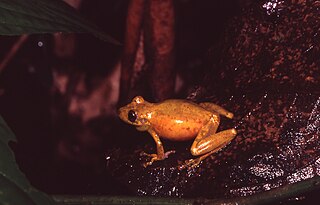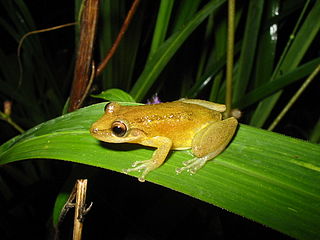Scinax altae is a species of frog in the family Hylidae. It is endemic to Panama where it occurs in the Pacific lowlands between the Chiriquí Province in the west and Panamá Province in the east. The type series was collected by Emmett Reid Dunn and his wife from "Summit" in the Panama Canal Zone in 1932.

Scinax alter, the Crubixa snouted treefrog, is a species of frog in the family Hylidae endemic to Brazil.

Scinax boulengeri is a species of frog in the family Hylidae. It is found in Colombia, Costa Rica, Nicaragua, Panama, and possibly Honduras. Its natural habitats are subtropical or tropical moist lowland forests, intermittent freshwater marshes, pastureland, plantations, rural gardens, and urban areas. It has been found as high as 600 meters above sea level.
Scinax chiquitanus is a species of frog in the family Hylidae. It is known from Amazonian Bolivia and from Department of Madre de Dios in Peru. The Peruvian populations might represent a distinct species.

Scinax cruentomma is a species of frog in the family Hylidae. It is found in the upper Amazon Basin of southern Colombia, eastern Ecuador, northeastern and east-central Peru, and western Brazil; its presence is French Guiana is dispted. The specific name cruentomma is derived from the Greek cruentos meaning "bloody" and omma meaning "eye", referring to the red streak in the eye of this frog. This species is also known as the Manaus snouted treefrog.
Scinax danae is a species of frog in the family Hylidae. It is endemic to southeastern Venezuela and occurs in the La Escalera region of the Sierra de Lema, Bolívar state. The specific name danae honors Dana Trueb Duellman, the daughter William E. Duellman, the scientist who described this species. Despite this, common name Bolivar snouted treefrog has been coined for this species.
Scinax exiguus is a species of frog in the family Hylidae. It is found in the Gran Sabana of Venezuela and in the Roraima state of the adjacent northern Brazil, as far south as Boa Vista, Roraima. Common name Gran Sabana snouted treefrog has been coined for it.

Scinax fuscomarginatus is a species of frog in the family Hylidae. It is found in northwestern Argentina, Paraguay, eastern Bolivia, southern, central, and eastern Brazil, and in scattered localities in the lowlands of eastern Venezuela and savannas of Guyana and southern Suriname as well as adjacent Brazil. As currently defined, it is one of most widespread Neotropical frogs; the northernmost records refer to what was formerly recognized as Scinax trilineatus. Common name brown-bordered snouted treefrog has been coined for this species.

Scinax ruber is a species of frog in the family Hylidae which is known in English as the red snouted treefrog or red-snouted treefrog, sometimes also Allen's snouted treefrog, the latter referring to the now-synonymized Scinax alleni. This widespread species is found in much of Amazonian and northern coastal South America and into Panama, as well as in some Caribbean islands as introduced populations. It is a complex containing several cryptic species.

Scinax onca is a species of frog in the family Hylidae. It is endemic to Brazil and known from the middle and southern parts of the Purus-Madeira interfluvial region in the Amazonas and Rondônia states. The specific name onca is derived from the local common name for jaguar and refers to the frog's blotchy color pattern; jaguars were also frequently spotted in the Purus–Madeira interfluvial region during the field work.

Scinax tropicalia, or Tropicalia's snouted treefrog, is a frog. Scientists report two distinct populations, both in Atlantic forest in Brazil. It lives no more than 600 meters above sea level.

Scinax tymbamirim is a frog in the family Hylidae. It is endemic to Brazil.

Scinax tsachila is a frog in the family Hylidae. It is endemic to Ecuador and probably also lives in Peru and Colombia. Scientists have seen from sea level to 1207 meters above sea level. It lives on the Pacific side of the contienent.
Scinax cabralensis is a frog in the family Hylidae. It is endemic to Brazil. Scientists observed some of these frogs 1070 meters above sea level.

Scinax juncae is a species of frog in the family Hylidae. It is endemic to Brazil.
Scinax cretatus is a frog in the family Hylidae endemic to Brazil.
Scinax montivagus is a frog in the family Hylidae. It is endemic to Brazil. It is known solely from its type locality in the Chapada Diamantina in the Espinhaço Range.
Scinax strussmannae, or Strüssmann's snouted tree frog, is a frog in the family Hylidae, endemic to dense rainforests in Brazil. It has been found in Nacentes do Lago Jari National Park.
Scinax ruberoculatus, the red-eyed snouted tree frog, is a frog in the family Hylidae. It is endemic to forest habitats in Brazil, Suriname, and French Guiana.
Scinax cosenzai is a species of frog in the family Hylidae. It is endemic to Brazil. People have seen it in the Parque Estadual da Serra do Brigadero in Minas Gerais.









